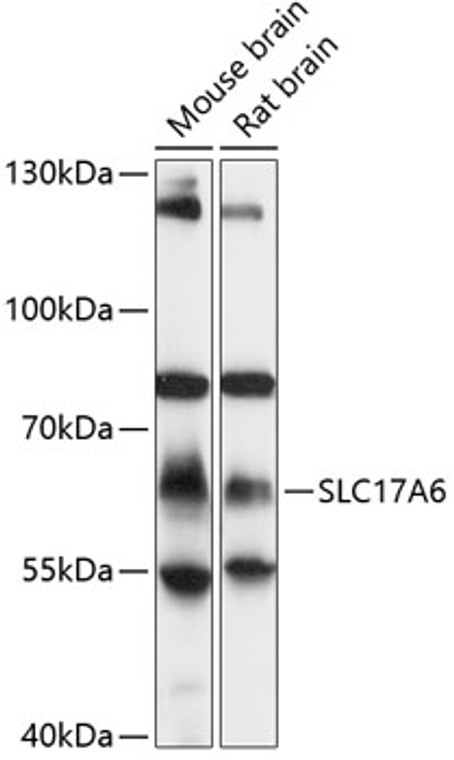| Host: |
Rabbit |
| Applications: |
WB |
| Reactivity: |
Mouse/Rat |
| Note: |
STRICTLY FOR FURTHER SCIENTIFIC RESEARCH USE ONLY (RUO). MUST NOT TO BE USED IN DIAGNOSTIC OR THERAPEUTIC APPLICATIONS. |
| Short Description: |
Rabbit polyclonal antibody anti-SLC17A6 (483-582) is suitable for use in Western Blot research applications. |
| Clonality: |
Polyclonal |
| Conjugation: |
Unconjugated |
| Isotype: |
IgG |
| Formulation: |
PBS with 0.01% Thimerosal, 50% Glycerol, pH7.3. |
| Purification: |
Affinity purification |
| Dilution Range: |
WB 1:500-1:2000 |
| Storage Instruction: |
Store at-20°C for up to 1 year from the date of receipt, and avoid repeat freeze-thaw cycles. |
| Gene Symbol: |
SLC17A6 |
| Gene ID: |
57084 |
| Uniprot ID: |
VGLU2_HUMAN |
| Immunogen Region: |
483-582 |
| Immunogen: |
A synthetic peptide corresponding to a sequence within amino acids 483-582 of human SLC17A6 (NP_065079.1). |
| Immunogen Sequence: |
AALVHYGGVIFYAIFASGEK QPWADPEETSEEKCGFIHED ELDEETGDITQNYINYGTTK SYGATTQANGGWPSGWEKKE EFVQGEVQDSHSYKDRVDYS |
| Tissue Specificity | Predominantly expressed in adult brain. Expressed in amygdala, caudate nucleus, cerebral cortex, frontal lobe, hippocampus, medulla, occipital lobe, putamen, spinal cord, substantia nigra, subthalamic nucleus, temporal lobe and thalamus. |
| Function | Multifunctional transporter that transports L-glutamate as well as multiple ions such as chloride, proton, potassium, sodium and phosphate. At the synaptic vesicle membrane, mainly functions as a uniporter which transports preferentially L-glutamate but also, phosphate from the cytoplasm into synaptic vesicles at presynaptic nerve terminals of excitatory neural cells. The L-glutamate or phosphate uniporter activity is electrogenic and is driven by the proton electrochemical gradient, mainly by the electrical gradient established by the vacuolar H(+)-ATPase across the synaptic vesicle membrane. In addition, functions as a chloride channel that allows the chloride permeation through the synaptic vesicle membrane therefore affects the proton electrochemical gradient and promotes synaptic vesicles acidification. Moreover, functions as a vesicular K(+)/H(+) antiport allowing to maintain the electrical gradient and to decrease chemical gradient and therefore sustain vesicular glutamate uptake. The vesicular H(+)/H(+) antiport activity is electroneutral. At the plasma membrane, following exocytosis, functions as a symporter of Na(+) and phosphate from the extracellular space to the cytoplasm allowing synaptic phosphate homeostasis regulation (Probable). The symporter activity is driven by an inside negative membrane potential and is electrogenic (Probable). Also involved in the regulation of retinal hyaloid vessel regression during postnatal development. May also play a role in the endocrine glutamatergic system of other tissues such as pineal gland and pancreas. |
| Protein Name | Vesicular Glutamate Transporter 2Vglut2Differentiation-Associated BnpiDifferentiation-Associated Na(+-Dependent Inorganic Phosphate CotransporterSolute Carrier Family 17 Member 6 |
| Database Links | Reactome: R-HSA-428643 |
| Cellular Localisation | Cytoplasmic VesicleSecretory VesicleSynaptic Vesicle MembraneMulti-Pass Membrane ProteinSynapseSynaptosomeCell Membrane |
| Alternative Antibody Names | Anti-Vesicular Glutamate Transporter 2 antibodyAnti-Vglut2 antibodyAnti-Differentiation-Associated Bnpi antibodyAnti-Differentiation-Associated Na(+-Dependent Inorganic Phosphate Cotransporter antibodyAnti-Solute Carrier Family 17 Member 6 antibodyAnti-SLC17A6 antibodyAnti-DNPI antibodyAnti-VGLUT2 antibody |
Information sourced from Uniprot.org
12 months for antibodies. 6 months for ELISA Kits. Please see website T&Cs for further guidance







